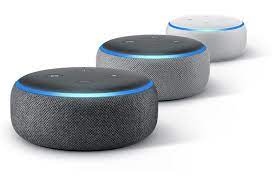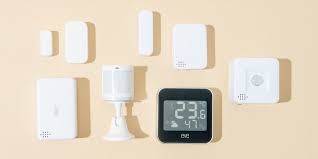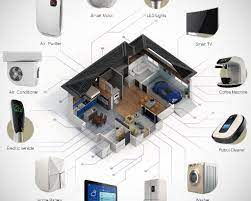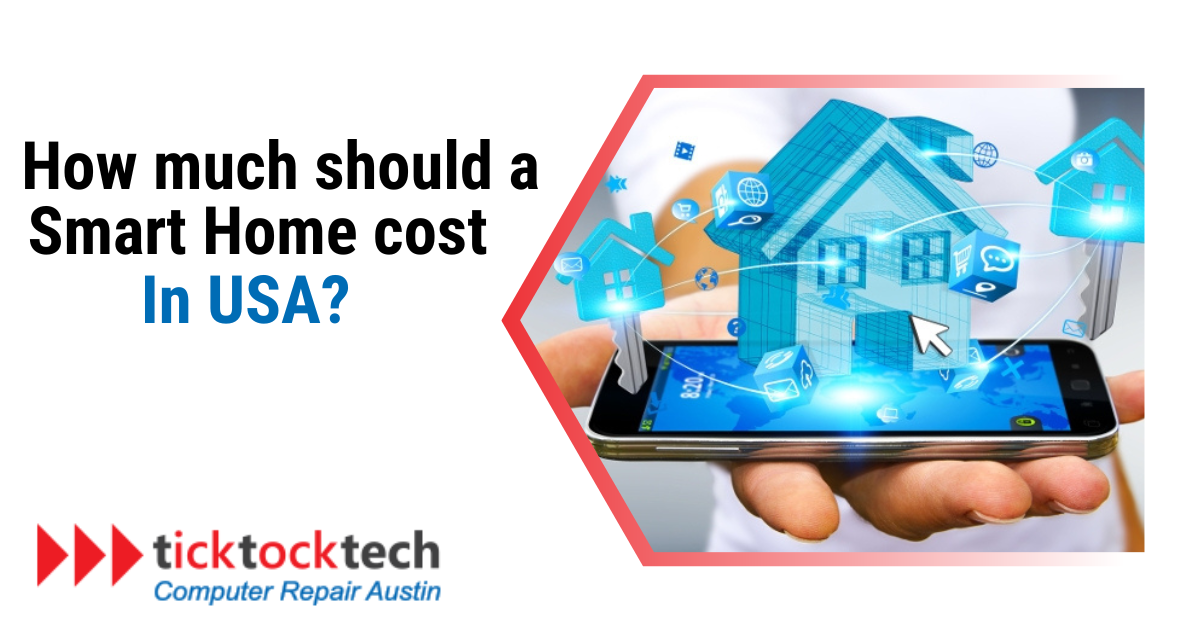Smart devices are the present and future, the ability to make use of gadgets in a stunning, interactive, and easy way. Thanks, to the constant and rapid development of artificial intelligence coupled with the Internet of Things (IoT) These technological innovations have been giving us gadgets that will not only make life easier but also in a very smart way. Smart home devices are gaining traction as they offer users different operatable gadgets.
There are different kinds of smart home devices each with different purposes, but the fun part is that they can work together to achieve the user’s goal. Ranging from security smart gadgets to smart faucets, plugs, vacuums, thermostats, and more. Most of these devices can be either controlled by hand gestures, voice commands, or programmed via apps.
However, you can combine these devices and control most of them via a single hub, all together. On a standard note, let’s take a look at how much a complete basic smart home setup would cost you in the United States. We will do this by demystifying each of these devices and their minimum and maximum prices. Let’s go…
How to get a Complete Smart home with different smart gadgets
Integrating multiple smart devices and maintaining their smooth communication and cooperation are necessary to create a fully connected smart home. Here is a step-by-step tutorial for connecting several smart home devices to build a complete system, including examples of each device.

1. Select a smart home hub
This device can control a variety of smart home and Internet of Things (IoT)-enabled appliances and systems, such as smart sensors on thermostats, lightbulbs, outlets, and switches, door locks and sensors, doorbells, garage door openers, energy monitors, and window coverings/coverings and sensors. Examples include Amazon Echo, Google Home, or Apple HomePod.
2. Establish Wi-Fi connections on all devices
Setting up your wireless router to be secure against intrusion and to protect the connected smart devices is necessary for a secure Wi-Fi network. This is important since your Wi-Fi network will be the primary means of communication for all of your smart devices with the internet.
Your smart home may be susceptible to cyberattacks, data breaches, and privacy invasions if you don’t take strong security precautions.
3. Have smart apps
The connected smart home app serves as a “universal remote” for all connected smart home devices, enabling the user to keep an eye on various components of the network and automate, plan, and manage operations.
Additionally, smart home applications can monitor surroundings and systems and issue alerts in the case of a problem with the right sensors. More and more, home automation hubs are being used to link and operate various devices across the house.
Examples include Apple HomeKit, Google Home, or SmartThings (Samsung), depending on the connectivity option of the item.
4. Install Smart Sensors
Smart sensors are essential parts of a smart home setup since they provide improved automation and security. These gadgets are necessary for contemporary home automation since detectors recognize changes in their surroundings and initiate planned actions or alarms.
There are many different kinds of smart sensors, including motion sensors, touch sensors for doors and windows, and environmental sensors. When motion is detected in a space, motion sensors can activate security cameras or automatically turn on lights.

By warning homeowners when an access point is compromised, door and window sensors improve security. A suitable interior atmosphere is maintained with the use of environmental sensors, such as those for temperature and humidity.
Motion sensors from Philips Hue and door/window sensors from Ring are two examples of smart sensors. Basic sensors start at roughly $20, but more sophisticated choices cost $30 to $50 or more.
5. Install Smart Bulb and Lightning
Adding smart lights and bulbs to your house is a game-changing move. By using smartphone applications or voice instructions through virtual assistants like Alexa or Google Assistant, these cutting-edge lamps may be operated remotely.
They provide you the flexibility of customizing the schedules, colors, and lighting to suit your tastes. Simply swap out your current incandescent lights for suitable smart ones, often putting them into the existing fixtures, to install them.
Reliable solutions come from companies like TP-Link and Philips Hue. Basic white smart lights start at roughly $10, but more sophisticated color-changing ones may cost between $20 and $50 per bulb.
6. Install Smart Security Facilities
Installing smart security features improves the security of your smart home and offers comfort. These gadgets include anything from security cameras and motion detectors to smart locks and video doorbells.

They may be integrated with other smart home devices and offer remote monitoring and control via smartphone apps. For keyless entry, smart locks may be installed on doors, and security cameras provide continuous monitoring.
A couple of examples are the $100 Ring Video Doorbell and the $130 Nest Cam Indoor. Systems with several cameras and cutting-edge features might go up to $500. Also, price depends on the brand, the features, and the quantity of devices required.
7. Install Smart Entertainment facilities
Smart TVs, sound systems, and streaming devices are just a few examples of the various gadgets included in smart entertainment facilities. By using voice commands or mobile applications, you may stream your preferred TV shows, films, and music.
To improve user engagement, they frequently support virtual assistants like Alexa or Google Assistant.
To install smart entertainment facilities, you must first link them to your Wi-Fi network, usually via specialized software. Additionally, your normal TV may be easily transformed into a smart TV by connecting to smart TVs and streaming devices like Apple TV or Roku.
Depending on your demands and choices, the price varies. Affordable alternatives include mid-range smart TVs that cost $500 to $1,000 and expensive sound systems that cost more than $1,000. The level of quality and features you may access will depend on your budget.
8. Implement Smart Appliances
Various functions like remote control, automation, and energy monitoring are available on smart appliances including smart refrigerators, washing machines, and ovens. For instance, a smart refrigerator may give you notifications when your supply of goods is getting low or even make shopping lists for you.
To reduce energy costs, smart washing machines may be programmed to run only when demand is low. Popular smart appliances include the Bosch Home Connect oven, LG ThinQ washing machine, and Samsung Family Hub refrigerator.
Depending on the brand, category, and features, smart appliances come in a broad range of prices. While entry-level devices may cost approximately $500, high-end ones with additional features might cost anywhere from $1,000 to $3,000 or more. In many cases, the initial expenditure is repaid over time through energy efficiency and convenience savings.
9. Integrate smart smoke detectors and Thermostats
Including smart thermostats and smoke alarms in your smart home improves security and energy efficiency. Smart smoke detectors link with other devices for coordinated actions, such as turning off HVAC systems in case of fire, and can remotely notify you of probable fires via smartphone alerts. They frequently replace older detectors and are simple to install. Also, Nest Protect and First Alert OneLink are two examples.
Energy costs are decreased by the efficient heating and cooling provided by smart thermostats like the well-known Nest and Ecobee. Installation entails quickly swapping out conventional thermostats. Smoke detectors may cost between $100 and $250, while smart thermostats can cost between $150 and $250. Both have long-term advantages in terms of safety and energy savings.
10. Install Shades and Blinds
The integration of motorized window coverings that can be remotely controlled via a smartphone app or voice commands is required for the installation of smart shades and blinds in a smart home.
These motorized window coverings provide convenience, improved privacy, and energy economy. The motorized devices are usually mounted, and connected to a home automation system, and the control parameters are set up during the installation process.
Then, users may operate the blinds or shades remotely to control natural light, preserve safety, and modify the temperature of the space. Smart window treatments range in price from $100 for entry-level devices to $500+ for sophisticated ones that work with voice assistants.
Conclusions – How much do smart home setups cost in the US?
Depending on your tastes and the size of your smart home ecosystem. The total cost of building a fully integrated smart home. Complete with numerous gadgets and equipment, often ranges from $3,000 to $10,000 or even more. These expenses cover the cost of smart hubs, sensors, lighting, security equipment, entertainment systems, and appliances.
Budgeting for workmanship costs is also advised; installation and setup services might cost an extra $1,000 to $3,000 on average. However, these numbers are approximations that may change depending on the brand, amount. Also, quality of the smart devices chosen, as well as any special needs or expensive installation services.

